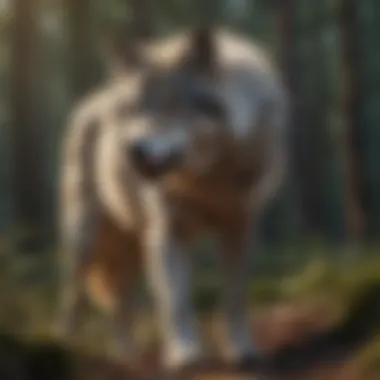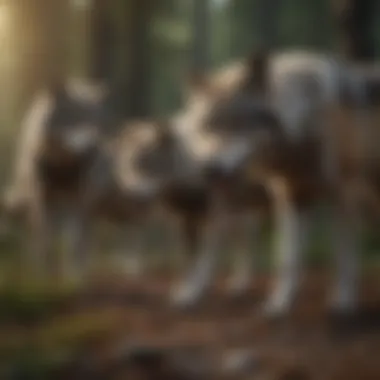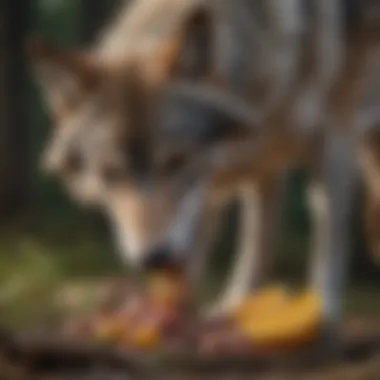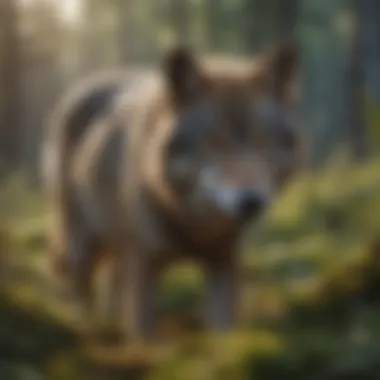Understanding the Diet of Wolves in the Wild


Nature Topic Overview
Wolves are fascinating animals that play a crucial role in their environments. Their diet is complex and reflects their adaptability and hunting prowess. Understanding what wolves eat helps us appreciate their role as important predators in the wild. This article explores their primary food sources, hunting strategies, and the implications of their eating habits on ecosystems.
Wolves primarily predate on large herbivores such as deer, elk, and moose. However, they also consume smaller animals and scavenged food. Their hunting strategies are social, often working together in packs to track and bring down prey. This cooperative behavior showcases their intelligence and social structure.
In ecological terms, wolves help maintain balanced populations of their prey species. Their presence influences the behavior of these animals, allowing vegetation to thrive and restoring habitats. Therefore, studying wolf diets is key to understanding ecosystem dynamics.
Fun Facts and Trivia
- Wolves have an excellent sense of smell. They can detect prey from several miles away.
- A single wolf can consume up to 20 pounds of meat in one meal! This is crucial during times of scarcity.
- Wolf packs can range from 2 to 30 members, depending on the food availability and habitat conditions.
These elements can make learning about wolves engaging for children. Visual aids like pictures of wolves in action can enhance understanding. Simple quizzes can test their knowledge, reinforcing what they learn.
Wildlife Explorations
Different types of wolves exist around the world, and each plays a unique role in its habitat. For example, the Gray wolf is the most common species found in the US and Canada. The Red wolf, now critically endangered, once roamed much of the eastern United States.
In addition to wolves, other animals play significant roles in the same ecosystems. Deer, elk, and other prey species create a balance in forest and grassland environments.
Interactive activities, like matching animals to their habitats, can aid learning. Puzzles about different wolf species can make facts memorable.
Environmental Awareness
Wolves are a key species in conservation efforts. Protecting their habitats is vital not just for wolves but for entire ecosystems. Children can learn to appreciate nature through simple actions, like supporting wildlife organizations and participating in local clean-ups.
Conservation projects are important. Engaging in conversations about why we need to protect habitats is fundamental. Children can contribute by educating others around them about the importance of wolves.
DIY Nature Activities
Engaging children with hands-on activities can energize their interest. Here are a few ideas:
- Create a wolf food chain model. Use paper animals and draw a diagram showing how wolves fit into the food web.
- Wolf tracking. Go outdoors and look for signs of wildlife. Paw prints and chew marks on bones can be intriguing!
- Nature journal. Encourage kids to keep a journal of their wildlife observations, noting special finds or facts about wolves and their prey.
These activities are not only fun but also educational. They allow children to connect theoretical knowledge with real-world experiences.
Prelude to Wolves
Wolves hold a significant place in nature, making them a fascinating subject for study. Understanding wolves starts with grasping their essential characteristics and the different species that inhabit various environments. This section will lay the groundwork for why these details are crucial in comprehending the diet of wolves and their role in ecosystems.
General Characteristics of Wolves
Wolves are social animals, known for their complex behaviors and strong social structures. Their pack mentality allows them to work together in hunting, raising pups, and defending their territory. They possess keen senses, especially their sense of smell, which plays a vital role in their survival. Understanding these characteristics adds depth to our comprehension of how their diets are shaped by their behaviors and environment.
The Different Species of Wolves
While many people think of wolves in general terms, each species exhibits unique traits and adaptations that significantly influence their dietary habits. Here, we explore the most notable species of wolves, focusing on their characteristics and how they contribute to our overall understanding of wolf diets.
Gray Wolves


Gray wolves are the largest members of the canine family. They range widely across North America, Europe, and Asia. A key characteristic of gray wolves is their social structure, commonly living in packs led by an alpha pair. This pack hunting strategy significantly affects their food sources, as they are capable of taking down larger prey. Their adaptability allows them to thrive in diverse habitats ranging from forests to tundras. This makes gray wolves a vital species to study, as their dietary habits reflect the health of their ecosystems.
Arctic Wolves
Arctic wolves, found in the harsh environments of the Arctic tundra, have distinct adaptations that enable them to thrive in extreme conditions. Their thick fur provides insulation against freezing temperatures. A notable aspect of their diet is their reliance on large mammals like caribou and muskoxen during the winter months. Understanding the Arctic wolf's diet illustrates how extreme environmental conditions can shape their feeding behaviors and overall survival strategy.
Red Wolves
Red wolves are one of the most endangered species of wolves in North America. They have a smaller size compared to gray wolves and usually inhabit wetlands and forests. Their diets commonly consist of small to medium-sized mammals, such as rabbits and rodents. The red wolf's unique position in the ecosystem highlights the importance of conservation efforts to maintain biodiversity and natural predation patterns, making them a critical focus in discussions about wolf diets.
Mexican Gray Wolves
Mexican gray wolves are the smallest species of wolf in North America and are considered critically endangered. They have a distinctive coat and smaller body size. This species typically preys on smaller mammals, such as deer and rodents, as well as livestock in some regions. Understanding their dietary needs and challenges is crucial for their conservation, as agriculture and habitat loss affect their feeding patterns. Their unique circumstances offer insight into broader ecological issues and the importance of protecting wolf habitats.
By exploring these elements, this section sets a foundational understanding leading into the diet of wolves, which will be crucial in highlighting their ecological roles and hunting strategies.
Understanding Wolf Diet
Understanding the diet of wolves is essential to grasp their role in nature and the way their eating habits shape ecosystems. Wolves are apex predators, meaning they help control the populations of other species. This balance is crucial not only for the health of those prey species but also for the overall environment. By studying what wolves consume, we can learn about their hunting strategies, their impact on prey populations, and how their diets change with the seasons. This section emphasizes why knowledge of a wolf's diet is fundamental to wildlife study, conservation efforts, and ecology.
What Do Wolves Eat?
Wolves are known for their diverse diets. Their food sources vary depending on the availability of prey, the season, and their location. The following are the primary components of a wolf's diet:
Mammals
Wolves primarily feast on large mammals. They tend to hunt animals such as deer, elk, and bison. These creatures are rich in nutrients and provide a substantial energy source for wolves, especially when they are in packs. The key characteristic of mammals like these is their size and fat content, making them a beneficial choice for wolves.
One unique feature of hunting mammals is that wolves can maximize their efficiency by engaging in pack hunting. This collective effort allows them to take down larger prey that they could not manage alone. However, hunting larger mammals can also be challenging, as it requires teamwork and communication.
Fruits and Vegetables
Wolves are not strictly carnivorous; they also consume fruits and vegetables when available. Common items in their diet include berries, apples, and grasses. These edible plants provide essential vitamins and minerals. The key characteristic here is that fruits and vegetables showcase the adaptability of wolves. This omnivorous behavior can be beneficial in lean times when meat is scarce.
However, the unique feature of fruits and vegetables is that they do not provide the same caloric intake as meat. So while they can supplement a wolf's diet, they cannot replace the need for protein obtained from mammals.
Smaller Animals
In addition to large mammals, wolves also hunt smaller animals. This includes creatures such as rabbits, hares, and rodents. The key characteristic of these smaller animals is that they can be quickly caught, which makes them a convenient food source.
Hunting smaller animals offers several advantages for wolves. They can sustain themselves in a variety of habitats and times when larger prey is not available. While these animals do not provide as much energy per kill as larger mammals, they contribute importantly to the wolves' overall diet.
The Importance of Meat
Meat is at the core of a wolf’s diet. It provides high levels of protein and fat necessary for their energy and survival. Wolves have evolved as hunters, developing strong muscles and keen senses to effectively pursue and capture their prey.
The importance of meat cannot be overstated; it is the primary driver of their feeding behavior and hunting tactics. Without a sufficient intake of meat, wolves would not be able to maintain their health, reproduce successfully, or function as effective predators within their ecosystems. This underscores the critical role of wolves in maintaining ecological balance.
Hunting Strategies of Wolves
Hunting strategies are essential to understanding how wolves survive and thrive in their habitats. Wolves are not just hunters; they are skilled predators with social behaviors that are vital for their success. Their methods of hunting can vary depending on the situation, the size of their pack, and the prey they target. By examining these strategies, readers can gain insight into the wolves’ adaptation methods and their role in the ecosystem.


Pack Hunting
Pack hunting is a remarkable feature of wolf behavior. In a pack, wolves work together to take down larger prey, which would be difficult or impossible to hunt alone. This social aspect allows them to maximize their efficiency and increase their chances of a successful hunt.
A wolf pack typically consists of family members, including the alpha pair, who lead the pack. The strength of the pack facilitates complex communication and strategic planning during hunts. For instance, wolves often use coordinated movements to herd animals into a specific area. This teamwork not only boosts survival but also strengthens social bonds within the pack. When wolves hunt together, the excitement and concentration are apparent.
"The social dynamics of a wolf pack are crucial for their success in hunts. Their interaction is as important as their physical ability."
Solo Hunting Techniques
Not all wolves hunt in packs. For various reasons, such as age, injury, or territory constraints, some wolves might hunt alone. This solo hunting is a test of skill and adaptability. Wolves that hunt alone need to rely heavily on their instincts and experience.
During solo hunts, wolves may focus on smaller prey or utilize stealth to make the kill. They often select locations that offer cover or a vantage point. These hunters must be strategic; their success depends on careful planning and execution. In some cases, they make calculated risks, often relying on scent and sound to detect their prey.
Stalking and Ambushing
Stalking and ambushing are crucial hunting tactics that showcase a wolf's patience and cunning. This method involves quietly approaching prey without being detected. Wolves use their acute senses of hearing and sight to identify the best moment to strike.
When a wolf stalks, it carefully chooses its path to minimize noise. The goal is to get within striking range while keeping the prey unaware. If the opportunity arises, the wolf can leap quickly to capture its lunch. In many instances, the ambush is successful, but it does require significant skill and training. Time is often an enemy, as the prey can often sense danger when the situation feels tense.
The Role of Wolves in Ecosystems
Wolves play a crucial role in maintaining the health and balance of ecosystems. As apex predators, they significantly influence prey populations, and their presence can lead to a diverse and vibrant environment. Understanding the role of wolves goes beyond just recognizing their hunting behavior; it allows us to appreciate their essential function in nature. By managing prey populations, wolves indirectly affect other species and vegetation, making them vital for ecological integrity.
Impact on Prey Populations
Wolves mainly hunt larger herbivores such as deer, elk, and moose. By keeping these populations in check, wolves prevent overgrazing and ensure that plant life can thrive. When herbivores are too abundant, they tend to consume more vegetation than an ecosystem can sustain. This leads to negative consequences for other species that rely on plants for food and habitat.
Wolves improve the health of prey populations as well. When they hunt, they tend to select weak, sick, or old animals. This process, known as selective predation, helps maintain strong genetic health in animal populations. Moreover, it encourages younger animals to grow and thrive as they will have better access to food resources during their formative years.
In areas where wolves have been reintroduced, such as Yellowstone National Park, the effects of their presence on prey populations have been remarkable. After the return of wolves, elk populations decreased, allowing vegetation to recover and flourish. This, in turn, benefited various other species, including beavers and birds, which depend on healthy ecosystems.
Effects on Vegetation and Land
The presence of wolves also has notable effects on vegetation and land in their habitats. As wolves regulate herbivore populations, plant communities can regenerate and grow. This change leads to increased biodiversity, which is essential for ecosystem stability. Richer plant life improves soil health, reduces erosion, and supports countless other species, including insects and small mammals.
Furthermore, healthy vegetation provides shelter for other animals, creating a more diverse wildlife community. Several studies show that when wolves are present, ecosystems are less susceptible to invasive plant species, allowing native species to flourish.
In summary, wolves serve as crucial agents of balance in ecosystems. Their role in controlling prey populations and influencing vegetation health highlights the complex interdependence of species in nature. As we continue to explore and protect these majestic animals, understanding their ecological importance helps ensure a sustainable environment for all species, including humans.
Seasonal Variations in Diet
Understanding the seasonal variations in diet of wolves is key to appreciating how these animals adapt to their changing environment. Wolves are highly adaptable predators. Their eating habits shift with the seasons, influenced by the availability of prey and environmental conditions. By examining these variances, we gain insights into their behaviors and survival strategies. This section will discuss how seasonal changes affect wolves' diet in both winter and summer, highlighting their flexibility and resourcefulness.
Winter Diet Preferences
During winter, food becomes scarce due to snow covering much of the ground. Animals that wolves hunt, like deer and elk, may also become harder to find. This challenging environment forces wolves to adapt their hunting techniques and preferences. They may focus on larger mammals since these provide more food per hunt.
Wolves tend to hunt in packs during winter. The pack's teamwork improves their chances of a successful hunt. They often target weaker or injured animals, which are easier to catch. The prey available in winter might include:
- Deer (particularly white-tailed and mule deer)
- Elk
- Bison
- Moose


Besides mammals, wolves may also consume carrion, which refers to the remains of dead animals. This is an important food source during harsh winters. Wolves have a strong sense of smell, enabling them to locate carrion buried beneath snow. Additionally, some wolves may eat small mammals like hares or rodents when larger prey is not available.
"Wolves can travel great distances in search of food during the winter months, showing their endurance and determination."
Summer Food Sources
As the temperatures rise and snow melts, wolves experience a diverse range of food options. Summer allows for a wider variety of prey to be more accessible. Vegetation also flourishes, making smaller animals more plentiful. In this season, wolves may change their diet to include a mix of larger and smaller animals. Some common summer food sources are:
- Small mammals like rabbits and voles.
- Birds and their eggs, which are abundant and provide essential nutrients.
- Fruits and vegetables, such as berries, that may be found in their environment.
Wolves often hunt smaller animals to meet their nutritional needs during summer. This adaptation helps them maintain their energy levels and support the growth of pups. Furthermore, the presence of prey, like deer, is still significant. Wolf packs may target fawns during this season when they are most vulnerable, providing a balance of prey from various sources.
Human Impact on Wolf Diet
Wolves, as apex predators, play a crucial role in maintaining the balance of ecosystems. However, human activities significantly affect their diet and overall survival. Understanding this impact is important for conservation efforts and wildlife management strategies. It helps us appreciate how interconnected our actions can be with the natural world.
Hunting and Habitat Loss
The impact of hunting, alongside habitat loss, is profound in shaping the diets of wolves. As humans expand their territories for agriculture, urbanization, and infrastructure development, wolf habitats shrink. This leads to reduced prey availability. Wolves rely on large areas to hunt and roam.
When their habitats are destroyed, wolves may turn to less ideal food sources such as livestock. This can cause conflict with farmers and result in attempts to control wolf populations through hunting. Additionally, overhunting of large prey species like deer, elk, or moose leads to food scarcity among wolf populations.
- It is important to note:
- Reduced natural prey increases competition among wolves.
- Some wolves may starve or abandon their packs to find food.
"The relationship between wolves and prey is essential for a healthy ecosystem."
In many regions, hunting regulations are put in place to balance wolf populations. These regulations are crucial for ensuring that wolves can find enough food.
Conservation Efforts
Conservation efforts aim to mitigate the negative impacts of human activities on wolf diets. These initiatives focus on protecting wolf habitats, ensuring adequate prey availability, and maintaining healthy ecosystems.
Some effective strategies include:
- Establishing protected areas where wolves can live without human disturbance.
- Implementing responsible hunting laws to preserve both prey and wolf populations.
- Promoting coexistence programs that help farmers protect their livestock while allowing wolves to thrive.
Education about wolves’ roles in the ecosystem is also vital. By understanding their dietary needs and hunting habits, communities can support measures that protect wolves and maintain biodiversity. Efforts to restore prey populations in areas affected by overhunting can also support a stable wolf diet.
Closure
Understanding the diet of wolves is critical for many reasons. Firstly, it informs us about their role as apex predators in various ecosystems. Wolves help maintain a balance in prey populations, which is essential for a healthy environment. When we look closely at what wolves eat, we can grasp the intricate relationships between different species and ecosystems.
Secondly, by studying their dietary habits, we gain insights into their behavior and social structure. For instance, the importance of pack hunting influences their food choices and hunting strategies. Recognizing these patterns helps us understand not just the wolves themselves but also the habitats in which they thrive.
Moreover, this knowledge plays a vital role in conservation efforts. By understanding wolf diets, we can identify how human activities, such as habitat loss and hunting, impact them. This awareness opens the door for more effective conservation strategies, safeguarding wolves and their environments.
In summary, comprehending the diet of wolves is not solely an academic pursuit; it touches upon ecology, behavior, and conservation. As we delve deeper into each of these areas, we recognize the importance of wolves in our natural world. The value of understanding their diet cannot be underestimated—it is essential for both the wolves and the ecosystems they inhabit.
The Importance of Understanding Wolf Diet
Understanding the diet of wolves is significant for several key reasons. First, it provides insight into their role in the ecosystem. Wolves are top predators, which means they help control other animal populations, particularly herbivores. If wolves influence these lower trophic levels, it allows vegetation and other wildlife to flourish. This balance is crucial for maintaining biodiversity.
Additionally, knowing what wolves eat informs conservation efforts. For example, if a specific prey species is declining, this can impact wolves' survival. Conservationists can use this information to create better strategies for protecting both wolves and their prey.
Also, understanding wolf diets can help educate people about the complexity of ecosystems. Many do not realize the interconnectedness between predators and other species. This knowledge fosters a greater appreciation for wildlife and the natural world.







